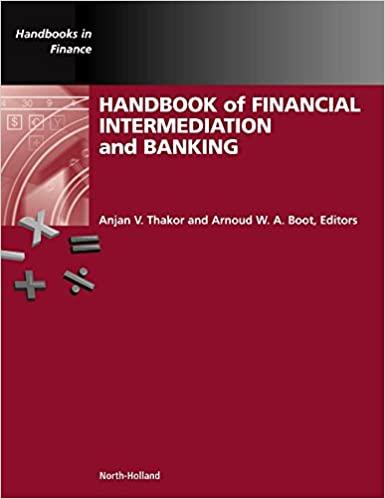Question
Suppose that you sell CDT short at $23 and at the same time you write a call option on CDT with a strike price of
Suppose that you sell CDT short at $23 and at the same time you write a call option on CDT with a strike price of $15 and a premium of $2. What is the combined profit or loss on the two positions together if just prior to expiration of the call option the price of CDT is $21? Assume that you cover your short position (meaning you get rid of the short position) just prior to the time of option expiration.
| a. | ($1) | |
| b. | $1 | |
| c. | ($2) | |
| d. | $0 | |
| e. | $2 |
Which of the following statements about moneyness of call and put options is FALSE?
| a. | Put options are out-of-the-money when strike price < the underlying stock price. | |
| b. | Option writers (also called sellers) must make payments to option buyers whenever the buyer exercises in-the-money options. | |
| c. | Call options are in-the-money when strike price > the underlying stock price. | |
| d. | Put options are at-the-money when strike price = the underlying stock price. | |
| e. | An option buyer would be advised to exercise any call or put option that is in-themoney and about to expire. |
Holding all else the same, the premium of a call option on common stock would decrease if: I. The price of the underlying stock increases. II. The volatility of the underlying stock increases. III. The time to expiration decreases.
| a. | I and II only | |
| b. | III only | |
| c. | I, II, and III | |
| d. | I only | |
| e. | I and III only
|
You buy a straddle on SD whose exercise price on the call and the put is $20. The premium on the call option is $0.15, and the premium on the put option is $11.00. Calculate the straddles profit or loss if just prior to expiration SDs stock price is $10 per share.
| a. | $11.15 | |
| b. | ($1.15) | |
| c. | $11.00 | |
| d. | ($11.15) | |
| e. | $1.15
|
Which of the following comes closest to the internal rate of return (IRR) of a project that requires an initial investment of $100 and produces TWO cash inflows: $100 at the end of year 3 and $160 at the end of year 10? The required rate of return for the project is 12%.
| a. | 15.75% | |
| b. | 4.81% | |
| c. | 12.00% | |
| d. | 6.05% | |
| e. | 16.07%
|
You buy a call option on a stock for a premium of $1.00. The exercise price is $31.50. What is the options profit or loss if just prior to expiration the stock price is $32.50?
| a. | $0 | |
| b. | $1.00 | |
| c. | ($0.50) | |
| d. | ($1.00) | |
| e. | $0.50
|
You write a put on Kane with an exercise price of $3.50 and a premium of $1.00. At the same time you buy a call on Kane with an exercise price also at $3.50 and a premium of $1.25. Calculate the profit or loss on both positions simultaneously if just prior to option expiration Kanes stock price is $3.00.
| a. | ($0.75) | |
| b. | ($0.50) | |
| c. | $0.00 | |
| d. | ($1.75) | |
| e. | ($1.25) |
Which of the following comes closest to the profitability index (PI) of a project that requires an initial investment of $100 and produces a single cash flow of $160 at the end of year 10 if the required rate of return is 12%?
| a. | 0.47 | |
| b. | 0.43 | |
| c. | 0.56 | |
| d. | 0.62 | |
| e. | 0.52
|
Which of the following values comes closest to the net present value of a project that requires an initial investment of $250 and produces cash flows of $60 per year for 10 consecutive years beginning at the end of year 5 (the cash flows go from the end of year 5 through the end of year 14)? The required rate of return is 12%?
| a. | ($64.70) | |
| b. | $1.81 | |
| c. | ($17.23) | |
| d. | ($50.32) | |
| e. | ($34.55)
|
Step by Step Solution
There are 3 Steps involved in it
Step: 1

Get Instant Access to Expert-Tailored Solutions
See step-by-step solutions with expert insights and AI powered tools for academic success
Step: 2

Step: 3

Ace Your Homework with AI
Get the answers you need in no time with our AI-driven, step-by-step assistance
Get Started


